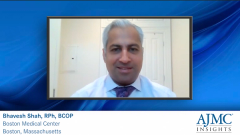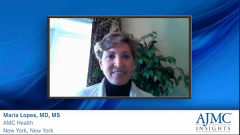
CVD Risk in Prostate Cancer: Quality Measures and Coverage Policy
Maria Lopes, MD, MS, elucidates the potential for quality measures and coverage policies to incorporate cardiovascular disease (CVD) and improve outcomes in prostate cancer.
Episodes in this series

Transcript:
Maria Lopes, MD, MS: Quality measures are usually at a population level. We don’t usually call out prostate cancer and ADT [androgen deprivation therapy] as a risk. There’s usually a heavy focus on HEDIS [Healthcare Effectiveness Data and Information Set] measures, which are part of NCQA [National Committee for Quality Assurance] accreditation, star performance measures, because that’s how CMS [Centers for Medicare & Medicaid Services]rewards us. To the extent that there’s a measure that focuses on prostate cancer and the risk of ADT and it’s actionable in terms of what we should be doing in terms of either outreach or education, that becomes important to accelerate this knowledge of ADT risk superimposed on cardiovascular risk and prostate cancer. General awareness may not be there at this time. Unless there’s a specific measure, we may still continue to, at a population level, look for cardiac risk factors, independent of whether you have prostate cancer. This adds another element of opportunities, specifically looking at cardiac risk, treatment medications, and perhaps how long you’ve even been a treatment. That highlights the magnitude of the risk benefit and perhaps something actionable that you can do to minimize the risk.
Understanding the safety issues with each product, we’re calling out as an informational note if someone already has cardiovascular risk, to assess risk benefit with a particular treatment if it has been demonstrated to compound cardiovascular risk. For agents who have less risk, we’re helping providers do a better assessment of risk benefit. If they have somebody with significant cardiovascular risk reduction, perhaps [we’re providing] a crosswalk to treatments that are safer—equally effective but safer alternatives. Hopefully we’re making the right decisions that are evidence based, but we’re not adding significantly to cost, hospitalizations, and events related to what already is a significant risk for that individual.
There are a lot of unmet needs for tools for clinicians and payers to identify what these patients are because we do this at a population level. But there’s not necessarily a crosswalk if you have prostate cancer or you’re on an ADT and you call out the subpopulation for further intervention. There’s certainly an opportunity for payers and providers to identify alternatives, and if they’re safer, to consider those in the management strategy.
Transcript edited for clarity.
Newsletter
Stay ahead of policy, cost, and value—subscribe to AJMC for expert insights at the intersection of clinical care and health economics.










































